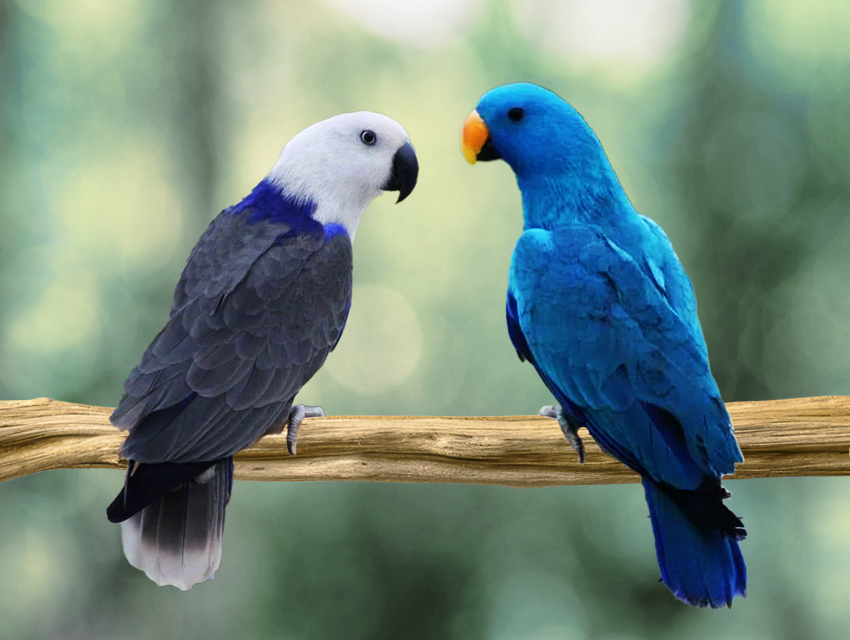Blue mutation Eclectus parrot
15 December 2023
In the Moluccan Eclectus parrot (Eclectus roratus), a rare mutation occurs in aviculture within some populations that produces a magnificent blue colouration of the plumage. The male bird is light blue, while the female shows a combination of dark blue, white and grey. These birds are highly sought-after in the hobby and large sums of money are often paid for blue birds and (chance) splits.
At NeorniLab, we have succeeded in being the first European laboratory to develop a genetic test that can detect the genetic variation responsible for the blue mutation in the Moluccan Eclectus.
But what exactly is this about? In this article, we reveal some more information about this unique genetic test in the Eclectus parrot.

About the blue colour mutation in the Moluccan Eclectus
Origin
Some sources claim that the first blue Eclectus parrots appeared in the early 1990s.
Colour mutations often arise spontaneously in a population with a certain degree of inbreeding. This is because that way recessive traits are more likely to be expressed. The blue phenotype (the appearance of a genetic background) in Eclectus parrots is also a recessive mutation. That is, birds only show blue plumage when the allele is present twice (once from the father, once from the mother). Birds that do not carry the mutation (called wild-type) or birds that only have the allele once (called carriers or split birds) will consequently show the normal wild colour.
Cause
Blue and red makes green

In a number of psittaciformes, psittacofulvin is produced. Psittacofulvin is a yellow-red pigment in the plumage. Together with the blue textured colour of the feathers, this makes the male largely green. In the female, which is largely blue-red, the disappearance of the red pigment will bring out a different textural colour in the areas that are normally red and thus lack blue textural colour.
The genetic variation we discovered at NeorniLab in Eclectus parrots causes a disorder in the production of this red pigment. As a result, the pigment is no longer produced as it should be and the blue or grey-white textured colour of the feathers emerges in certain feather areas.
Inheritance
The inheritance of the blue mutation is autosomal recessive. This makes the following combinations possible:
- Split x Split gives 25% blue, 50% split, 25% wildtype
- Split x Blue gives 50% blue and 50% split
- Split x Wildtype gives 50% split and 50% wildtype
- Blue x Blue gives 100% blue
Tracking the colour mutation in the blue Eclectus
Genetic test
At NeorniLab, we have recently succeeded in being the first European laboratory to develop a genetic test that can detect the genetic variation responsible for the blue mutation in the Eclectus parrot (Eclectus roratus). After extensive testing of a large number of birds, we have developed a reliable method to identify split birds.
What is the big advantage of this test?
Until now, split birds were often sold as 'chance splits'. This has a number of consequences:
For one thing, as a breeder, you must first have bred blue Eclectus parrots from a pair to be sure that both Eclectus parrots are carriers of the mutation. To do so, you must keep the birds for a long time, they must be willing to breed and, in addition, you must breed enough offspring to be sure. Split birds in couples where only 1 of the parents is split will not be detected and valuable parent birds will thus not be used to their full potential.
On the other hand, as a seller you cannot prove that your birds are 100% sure carriers of the mutation and all birds are therefore bought as 'chance splits'. So even if the seller is in good faith, it is difficult to prove that the birds are 100% split.
That is now changing:
- Thanks to this genetic test, you can prove through your unique NeorniLab certificate that the birds are carriers of the mutation (100% split).
- More targeted and faster breeding for the blue mutation is possible. The use of 'test couples' to identify possible split birds is no longer necessary.
Which samples are suitable?
A feather sample is sufficient for this test. If blood is sent in for a disease test, blood can also be used. Samples can be sent in by post or handed in at NeorniLab at reception.
What can you expect?
After completion of the test, you will receive a certificate with the result of the analysis and a unique certificate code. Using this code, you can later verify the authenticity of the certificate with us by checking whether the bird with a certain ring number matches this certificate code.
